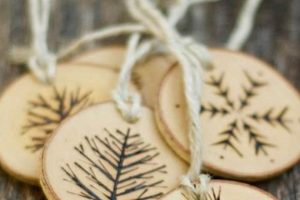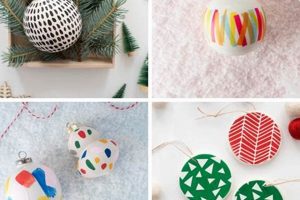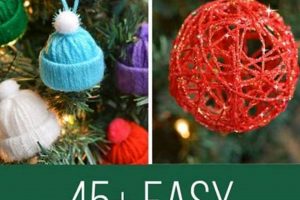Handcrafted decorations incorporating sparkling particles affixed to a base object, typically spherical, are frequently created for seasonal adornment. These individualized items serve as festive embellishments. An example involves applying adhesive to a clear glass ball and then coating it with fine, iridescent material to produce a shimmering effect.
The creation of personalized holiday decorations offers avenues for creative expression and can foster a sense of accomplishment. Engaging in such activities promotes mindfulness and provides an alternative to commercially produced alternatives. Historically, the practice of crafting ornaments dates back centuries, with evolving materials and techniques reflecting cultural shifts and technological advancements.
Subsequent sections will detail the supplies required, step-by-step construction methodologies, and safety considerations for producing these bespoke embellishments. These instructions will enable the reader to confidently undertake the project.
Tips for Successful Glitter Ornament Creation
The following recommendations are intended to improve the quality and longevity of handcrafted, sparkling seasonal decorations.
Tip 1: Select Appropriate Adhesive. The choice of bonding agent significantly affects the outcome. Opt for a non-toxic, slow-drying glue specifically formulated for crafting. Rapid-drying adhesives may create uneven surfaces and prevent optimal particle adhesion.
Tip 2: Employ Fine-Grade Particles. The size and quality of the shimmering material influence the final aesthetic. Use finely milled, uniform particles to achieve a smooth, consistent finish. Coarser varieties can result in a textured, less refined appearance.
Tip 3: Prepare the Surface Adequately. Clean and prepare the ornament surface before applying adhesive. Remove any oils, dust, or debris to ensure proper adhesion. For glass ornaments, wiping with rubbing alcohol is recommended.
Tip 4: Control Application Volume. Apply the adhesive in thin, even layers. Excessive amounts can lead to drips, clumps, and prolonged drying times, potentially compromising the ornament’s structural integrity.
Tip 5: Implement a Containment Strategy. This work is inherently messy. Work in a designated area covered with protective material, such as parchment paper, to facilitate easy cleanup and prevent particle dispersion.
Tip 6: Allow for Complete Drying. Prior to handling or displaying the finished product, ensure that both the adhesive and the applied particles are completely dry. This typically requires a minimum of 24 hours in a well-ventilated area.
Tip 7: Apply a Sealer (Optional). A clear, non-yellowing sealant can be applied to minimize particle shedding and enhance the ornament’s durability. Ensure the sealant is compatible with both the adhesive and the base material.
Adhering to these guidelines can significantly improve the visual appeal and structural integrity of personalized, shimmering holiday decorations, ensuring their longevity and aesthetic value.
The subsequent section will address potential safety precautions associated with the materials and processes involved in ornament construction.
1. Adhesive Selection
The choice of adhesive is paramount in the construction of handcrafted, sparkling ornaments. It directly influences the adhesion of particles, the final aesthetic, and the ornament’s structural integrity. Careful consideration of adhesive properties is crucial for a successful project.
- Bond Strength
The adhesive’s ability to form a robust bond with both the ornament’s base material and the particles is essential. Weak bonding results in particle shedding and a diminished aesthetic appeal. For example, a polyvinyl acetate (PVA) glue, commonly known as white glue, offers adequate strength for many porous surfaces, while epoxy resins provide superior adhesion for non-porous materials like glass. The selected adhesive must withstand handling and environmental factors.
- Drying Time
The adhesive’s drying time impacts the application process and the final finish. Rapid-drying adhesives may prevent even particle distribution, leading to a textured, uneven appearance. Conversely, excessively slow-drying adhesives prolong the project timeline and increase the risk of smudging or displacement. A moderate drying time, typically between several minutes and a few hours, allows for adjustments and ensures uniform particle coverage.
- Viscosity
Adhesive viscosity, or thickness, determines its spreadability and penetration into the ornament’s surface. High-viscosity adhesives may be difficult to apply evenly, leading to clumps and inconsistencies. Low-viscosity adhesives may run or drip, resulting in thin or bare patches. A medium-viscosity adhesive provides optimal control and ensures uniform coverage without excessive dripping.
- Clarity and Color
The adhesive’s clarity and color impact the final visual appearance. Opaque or colored adhesives can obscure the particles or alter their perceived hue. A clear, colorless adhesive preserves the particles’ inherent brilliance and ensures that they remain the focal point of the design. Certain craft-specific glues are designed to dry clear, mitigating potential discoloration.
The interplay between bond strength, drying time, viscosity, and clarity underscores the importance of judicious adhesive selection in crafting personalized, shimmering decorations. By carefully considering these factors, the likelihood of producing durable, visually appealing ornaments is significantly enhanced.
2. Particle Fineness
The texture of handcrafted, sparkling ornaments is fundamentally influenced by the size and uniformity of the particles employed. Particle fineness directly impacts the smoothness, reflectivity, and overall aesthetic appeal of the finished product. The use of coarse particles results in a rough, textured surface that scatters light unevenly, potentially diminishing the ornament’s brilliance. Conversely, finely milled particles create a smoother, more reflective surface that maximizes light diffusion and enhances the ornament’s visual impact. An example illustrates this principle: an ornament coated with coarse, craft-store grade material exhibits a noticeably different sheen compared to one finished with professional-grade, ultra-fine particles. The former appears grainy and less vibrant, while the latter displays a polished, jewel-like quality.
Beyond aesthetics, particle fineness affects the ease of application and adhesion. Ultra-fine particles tend to adhere more readily to adhesive, forming a more cohesive layer and reducing the likelihood of shedding. This is particularly relevant for ornaments intended for frequent handling or display in environments with fluctuating temperatures. The selection of appropriate particle fineness, therefore, constitutes a crucial decision in the crafting process, impacting both the visual and functional characteristics of the ornament. Practical application includes understanding that different particle sizes can also be used in conjunction to achieve a desired effect, combining a base layer of ultra-fine material with strategically placed accents of coarser particles for added texture and dimension.
In summation, particle fineness functions as a critical determinant in the crafting of sparkling ornaments. Its influence extends beyond mere visual considerations, affecting the durability and overall quality of the finished item. While challenges may arise in sourcing consistently fine particles, the investment in higher-quality materials demonstrably elevates the aesthetic and longevity of personalized, shimmering decorations. This understanding directly links to the broader goal of crafting durable and visually appealing seasonal embellishments.
3. Surface Preparation
In the context of crafting sparkling decorations, surface preparation exerts a direct and demonstrable influence on the quality and longevity of the finished product. The presence of contaminants, such as oils, dust, or residual manufacturing compounds, inhibits proper adhesive bonding. For instance, an ornament constructed from uncleaned glass will exhibit significantly reduced particle adhesion compared to one meticulously cleansed with isopropyl alcohol prior to adhesive application. The cause-and-effect relationship is clear: inadequate preparation results in particle shedding, compromised aesthetic appeal, and a shortened lifespan for the ornament.
Effective surface preparation methods vary depending on the base material. Glass ornaments often benefit from cleaning with a solvent, followed by a lint-free cloth drying. Wooden ornaments require sanding to create a receptive texture and removal of any loose debris. Plastic surfaces may need a gentle abrasion to promote adhesion. Regardless of the method, the objective remains consistent: to establish a clean, uniform substrate that maximizes the adhesive’s ability to form a strong, lasting bond. This step is not merely cosmetic; it is a structural component that determines the ornament’s resistance to environmental factors and handling.
The practical significance of proper surface preparation extends beyond the individual ornament. When scaling production or teaching crafting techniques, emphasizing this step ensures consistent results and minimizes material waste due to adhesion failures. Addressing the challenge of inconsistent surface conditions, such as variations in manufacturing processes, requires a proactive approach to quality control. By meticulously preparing surfaces, crafters mitigate the risk of compromised aesthetics and structural weaknesses, resulting in durable, visually appealing seasonal embellishments.
4. Application Control
The strategic management of adhesive and particle distribution represents a critical factor in the creation of handcrafted, sparkling decorations. Application control dictates the uniformity, density, and overall aesthetic of the finished ornament, significantly influencing its visual appeal and structural integrity. Precise execution minimizes material waste and ensures a polished final product.
- Adhesive Layer Uniformity
The consistency of the adhesive layer directly impacts particle adhesion. Uneven application leads to variable particle density, resulting in patchy or textured surfaces. Techniques such as using a fine-tipped applicator or employing a rotating jig ensure a uniform adhesive coating, which promotes even particle distribution and a consistent visual finish. For example, a thick layer of adhesive might cause particle clumping, while a thin layer might lead to insufficient adhesion.
- Particle Density Management
The quantity of particles applied per unit area determines the ornament’s overall sparkle and visual density. Over-application can result in a dull, obscured surface, while under-application leads to a sparse and incomplete appearance. Controlled application techniques, such as using a sifter or carefully sprinkling particles over the adhesive, enable precise density management, achieving a balanced and visually appealing result. Varying densities can also create visual effects, such as gradients or focal points.
- Containment of Excess Material
The application process inherently generates excess particles. Managing this excess minimizes material waste and prevents contamination of the surrounding environment. Utilizing a dedicated workspace lined with collection trays or employing electrostatic applicators to attract particles to the adhesive surface reduces material loss and facilitates efficient cleanup. Reclaiming unused particles reduces waste and lowers material costs.
- Precision Placement for Design
Application control extends beyond uniform coverage to encompass deliberate design elements. The ability to precisely place particles allows for the creation of intricate patterns, gradients, and focal points on the ornament’s surface. Techniques such as using stencils or applying particles with a fine brush enable the execution of complex designs. The successful integration of these design elements enhances the ornament’s visual complexity and artistic merit.
These facets of application control collectively contribute to the creation of aesthetically pleasing and structurally sound handcrafted decorations. Mastery of these techniques empowers the crafter to realize intricate designs, minimize material waste, and consistently produce high-quality, personalized, shimmering ornaments. Control during each aspect, from adhesive application to the final particle placement, defines the distinction between amateur and professional results.
5. Drying Time
The duration required for adhesives and coatings to fully cure is a critical determinant in the creation of durable and aesthetically pleasing handcrafted decorations. Insufficient drying time compromises the structural integrity and visual quality of the finished item, leading to particle shedding, surface tackiness, and potential damage during handling. Proper understanding and management of this period are therefore essential for successful ornament construction.
- Adhesive Cure Strength
Adhesive cure strength directly correlates with drying time. Premature handling before the adhesive reaches its full bonding potential results in weakened particle adhesion. For example, ornaments moved or packaged before complete curing are susceptible to particle dislodgement and diminished aesthetic appeal. Different adhesive formulations necessitate varying cure times; cyanoacrylate adhesives cure rapidly, while epoxy resins require extended periods. Full cure strength is essential for ornaments intended for long-term display and frequent handling.
- Environmental Influence on Drying
Ambient temperature and humidity significantly affect drying time. Elevated humidity levels impede evaporation, prolonging the drying process and potentially causing adhesive clouding or surface tackiness. Low temperatures can also slow down curing reactions. Maintaining a controlled environment, characterized by moderate temperature and low humidity, optimizes drying conditions and ensures consistent results. An example: ornaments drying in a damp basement will require considerably longer cure times than those in a climate-controlled room.
- Impact on Sealer Application
Application of a sealant prior to complete adhesive curing compromises the sealant’s effectiveness. Trapped solvents within the uncured adhesive can interfere with the sealant’s bonding properties, leading to peeling, bubbling, or discoloration. Allowing sufficient drying time for the adhesive is crucial for creating a stable base for the sealant. The sealant serves to lock particles in place and provide an additional layer of protection against environmental factors. Premature sealing undermines this protection.
- Viscosity and Layer Thickness Effects
The viscosity of the adhesive and the thickness of the applied layer influence the required drying time. Thicker, more viscous adhesives necessitate longer cure periods to ensure complete solvent evaporation and full bonding. Multiple thin coats, rather than a single thick coat, promote more uniform drying and minimize the risk of trapped solvents. An illustration: a thick layer of craft glue may appear dry on the surface but remain uncured internally, leading to subsequent cracking or particle shedding.
These interconnected factors underscore the importance of meticulously managing drying time in the context of handcrafted decorations. Ignoring this crucial step leads to compromised durability and diminished aesthetic appeal. Recognizing and addressing these facetsadhesive cure strength, environmental influences, sealer application timing, and viscosity/layer thickness effectsis essential for producing high-quality, long-lasting shimmering ornaments.
6. Sealing Method
The application of a protective coating, or sealing method, represents a critical final step in the construction of durable and visually appealing handcrafted, shimmering decorations. Its primary function is to encapsulate the applied particles, minimizing shedding and enhancing resistance to environmental degradation. Selection of an appropriate sealing method directly impacts the ornament’s longevity and maintenance requirements.
- Sealant Type and Compatibility
The chemical composition of the sealant must be compatible with both the adhesive and the base material of the ornament. Incompatible sealants can cause discoloration, cracking, or adhesion failure. For example, acrylic-based sealants are often suitable for use with water-based adhesives and plastic ornaments, while solvent-based sealants may be required for resin or glass substrates. Incorrect selection can lead to delamination or a compromised visual finish. Consider the material properties of each component.
- Application Technique and Coverage
Uniform sealant application is essential for consistent protection. Inadequate coverage leaves areas vulnerable to particle loss, while excessive application can result in runs, drips, or a cloudy finish. Techniques such as using a fine-mist aerosol sprayer or applying thin, even coats with a brush promote optimal coverage and minimize visual defects. Proper technique ensures a durable and aesthetically pleasing seal. Insufficient control degrades the integrity of the seal.
- Environmental Considerations
The sealant’s resistance to environmental factors, such as ultraviolet (UV) radiation, humidity, and temperature fluctuations, directly impacts the ornament’s lifespan. Sealants formulated with UV inhibitors prevent fading or yellowing, while those with moisture resistance protect against water damage. Selecting a sealant appropriate for the intended display environment is crucial for maintaining the ornament’s visual appeal over time. Internal or external use cases have different protection requirements.
- Finish and Clarity
The sealant’s finish, whether glossy, matte, or satin, influences the ornament’s final aesthetic. A clear, non-yellowing sealant preserves the particles’ inherent brilliance and ensures that they remain the focal point of the design. Opaque or colored sealants can obscure the particles or alter their perceived hue. Proper sealant selection enhances the overall visual impact of the handcrafted decoration. Aesthetic considerations guide sealant finish choice.
These four facets collectively demonstrate the significance of a well-executed sealing method in crafting durable and visually appealing, shimmering decorations. By carefully considering sealant type, application technique, environmental resistance, and finish, crafters can significantly enhance the longevity and aesthetic value of their personalized seasonal embellishments. Comprehensive attention ensures a lasting, high-quality product.
Frequently Asked Questions
This section addresses common inquiries and concerns regarding the creation of personalized, shimmering ornaments, providing factual and objective information to enhance the crafting process.
Question 1: Is specialized equipment required for ornament construction?
While specialized equipment may facilitate certain aspects of the crafting process, it is not strictly necessary. Essential materials typically include adhesive, a base ornament (e.g., glass, plastic, or wood), fine or coarse particles, and a sealant. Advanced techniques may benefit from the use of spray booths or electrostatic applicators, but these are optional.
Question 2: What safety precautions should be observed during construction?
Adequate ventilation is paramount due to potential inhalation hazards associated with certain adhesives and sealants. Eye protection is recommended to prevent particle irritation. Skin contact with adhesives should be minimized, and appropriate hand protection employed. A designated workspace should be established to contain loose particles and facilitate cleanup.
Question 3: How can particle shedding be minimized after completion?
The application of a sealant specifically designed for craft projects is crucial. Ensure the sealant is compatible with both the adhesive and the ornament’s base material. Multiple thin coats of sealant are generally more effective than a single thick coat. Allow the sealant to fully cure according to the manufacturer’s instructions.
Question 4: What types of adhesives are best suited for different ornament materials?
Polyvinyl acetate (PVA) glues are generally suitable for porous materials such as wood or paper. Cyanoacrylate adhesives offer rapid bonding for non-porous materials like glass or plastic. Epoxy resins provide superior adhesion and durability for demanding applications. Compatibility with the ornament’s surface is a primary consideration.
Question 5: How does the size of the particles affect the final aesthetic?
Fine particles create a smooth, reflective surface, while coarser particles produce a textured, glittery effect. The choice depends on the desired visual outcome. Experimentation with varying particle sizes allows for personalized designs and unique aesthetic effects.
Question 6: Can finished ornaments be safely stored from year to year?
Proper storage is essential to prevent damage or degradation. Ornaments should be stored in acid-free tissue paper within a rigid container to protect them from physical impact and environmental exposure. Avoid exposure to direct sunlight or extreme temperatures during storage.
In summary, the creation of durable and visually appealing ornaments requires attention to detail and adherence to established best practices. Proper material selection, safety precautions, and finishing techniques are essential for achieving optimal results.
The subsequent section will explore the potential for commercial applications of these crafting techniques.
Conclusion
This exploration has detailed essential considerations for producing durable and aesthetically pleasing handcrafted decorations. Material selection, application techniques, and finishing processes each exert a significant influence on the final product. By meticulously attending to these factors, crafters can enhance the longevity and visual impact of personalized shimmering ornaments.
The creation of “diy glitter ornaments” represents an opportunity for creative expression and the production of unique seasonal embellishments. Success hinges on informed practices and diligent execution. The enduring appeal of these decorations lies in their capacity to impart a personalized touch to traditional celebrations.







